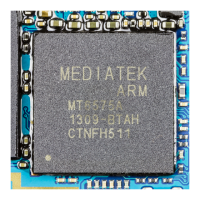Memory Management Unit
ARM DDI 0388I Copyright © 2008-2012 ARM. All rights reserved. 6-2
ID073015 Non-Confidential
6.1 About the MMU
The MMU works with the L1 and L2 memory system to translate virtual addresses to physical
addresses. It also controls accesses to and from external memory.
The Virtual Memory System Architecture version 7 (VMSAv7) features include the following:
• page table entries that support 4KB, 64KB, 1MB, and 16MB
• 16 domains
• global and address space identifiers to remove the requirement for context switch TLB
flushes
• extended permissions check capability.
See the ARM Architecture Reference Manual for a full architectural description of the VMSAv7.
The processor implements the ARMv7-A MMU enhanced with Security Extensions and
multiprocessor extensions to provide address translation and access permission checks. The
MMU controls table walk hardware that accesses translation tables in main memory. The MMU
enables fine-grained memory system control through a set of virtual-to-physical address
mappings and memory attributes.
In VMSAv7 first level descriptor formats page table base address bit [9] is
implementation-defined. In Cortex-A9 processor designs this bit is unused.
The MMU features include the following:
• Instruction side micro TLB
— hardware configurable 32 or 64 fully associative entries.
• Data side micro TLB
— 32 fully associative entries.
• Unified main TLB
— 2-way associative:
2x32 entry TLB for the 64-entry TLB.
2x64 entry TLB for the 128-entry TLB.
2x128 entry TLB for the 256-entry TLB.
2x256 entry TLB for the 512-entry TLB.
— 4 lockable entries using the lock-by-entry model.
— supports hardware page table walks to perform lookups in the L1 data cache.
6.1.1 Memory Management Unit
The MMU performs the following operations:
• checking of Virtual Address and ASID
• checking of domain access permissions
• checking of memory attributes
• virtual-to-physical address translation
• support for four page (region) sizes
• mapping of accesses to cache, or external memory
• TLB loading for hardware and software.

